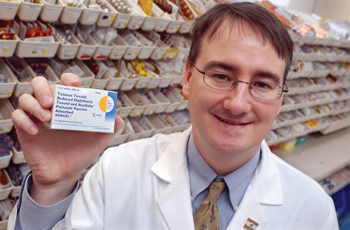
Tom Talbot, M.D., holds the adacel vaccine for tetanus, diphtheria and pertussis. (Photo by Dana Johnson)
Study examines new pertussis prevention option
Vanderbilt University Medical Center infectious diseases researchers are studying whether health care workers previously vaccinated for pertussis who are later exposed to someone infected with pertussis still require additional antibiotics, the current standard treatment.
At VUMC, the current suggested treatment for a health care worker exposed to pertussis is a five-day course of antibiotics. If the employee develops signs or symptoms of pertussis, he or she is furloughed off work and given further treatment while they still may be contagious.
Since the Centers for Disease Control and Prevention (CDC) now recommends vaccination of all health care workers against pertussis, what remains unclear is whether antibiotic treatment is necessary, said Tom Talbot, M.D., M.P.H., VUMC's chief hospital epidemiologist and the study's principal investigator.
“If you've been vaccinated you should be protected from infecting others. You potentially may not need to take antibiotics , and you may not have to go through this whole complicated process,” Talbot said.
“But this hypothesis needs to be tested.”
Talbot and co-investigator William Goins II, M.D., clinical fellow in Infectious Diseases, seek to enroll 1,000 faculty and staff of the Monroe Carell Jr. Children's Hospital at Vanderbilt for this two-year study to test the theory that vaccinated health care workers should no longer be able to transmit pertussis and do not require antibiotic treatment following exposure to a person with the infection.
The CDC grant for this study is unique to VUMC because the entire study population involves only health care workers at Children's Hospital.
“The reason we picked Children's Hospital is because children still represent the population with the largest number of pertussis infections, and the faculty and employees of Children's know all too well the potentially devastating effects of severe pertussis infection in kids,” Talbot said.
Every health care worker who enrolls in the study will receive the pertussis vaccine. Employees who receive a pertussis vaccine through Occupational Health are also eligible to participate in this study.
“One group will receive antibiotics, which is the current, standard therapy. And the other group will be carefully watched, but will receive no antibiotics,” Talbot said. “We will watch each group closely for three weeks after exposure, which is the risk period.”
The study's outcome seeks to determine if the rate of spread of pertussis to the health care worker, either by outward symptoms, or by positive antibodies, is the same in both groups. “Will the antibiotics make a difference?” Talbot said.
Pertussis, commonly known as whooping cough, remains a health threat year round. Although a vaccine has been widely used in the United States since the 1950s, the disease remains one of the country's most transmittable infectious diseases.
While children are most at risk for pertussis, the disease is increasingly a cause of infection in adults. It often presents atypically in older persons, with the only symptom being a chronic, persistent cough.
The current vaccine, administered to all U.S. children during the battery of required childhood vaccines, is more than 90 percent effective. Researchers now know the pertussis vaccine remains effective for about a decade.
“Over the last 10 or 15 years the incidence of pertussis has been increasing,” Talbot said. “We have especially seen this increase in adolescents and adults.”
Talbot says because the incidence of pertussis has been increasing, vaccine manufacturers have developed an effective pertussis adult booster, which is now combined with tetanus booster shots. The CDC recommends this vaccine for all adolescents and adults.
“What has also been increasingly recognized is potential for spread of whooping cough from infected patients to health care workers, who can then spread the disease to other patients, their co-workers, and their families.
“Outbreaks of pertussis in hospitals have been traced back to health care workers who likely acquired the infection from a patient,” Talbot said.
This increasingly recognized role of health care workers in the potential spread of pertussis led the CDC to recommend last year that all health care workers receive the pertussis vaccine.
“This is one of the leading contagious disease exposures seen in hospitals around the world. So it's definitely a problem,” Talbot said.
Data provided by Vanderbilt Occupational Health indicates there were almost 500 VUMC employees exposed to pertussis from 2003-2005, said Goins.
“Most health care workers just don't recognize they are at risk for exposure to pertussis within a hospital. And they don't appreciate the risk of spreading it to patients.”
Talbot says this study will have an impact on not only how VUMC cares for its own employees, but also will set national and international standards on how pertussis exposures in the health care setting are managed.
“This is a great opportunity for Children's Hospital to position itself to answer this question,” he said. “We'll need everyone's help to hopefully make a huge difference in how these exposures are managed by all hospitals.”
Children's Hospital employees who would like more information about the Vanderbilt Pertussis Exposure Study can call 936-3686 for more information.













